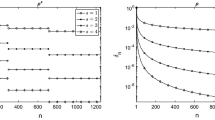Abstract
We determine the exact order of ɛ-complexity of the numerical integration problem for the anisotropic class W r∞ (Id) and H r∞ (Id) with respect to the worst case randomized methods and the average case deterministic methods. We prove this result by developing a decomposition technique of Borel measure on unit cube of d-dimensional Euclidean space. Moreover by the imbedding relationship between function classes we extend our results to the classes of functions W Λp (Id) and H Λp (Id). By the way we highlight some typical results and stress the importance of some open problems related to the complexity of numerical integration.
Similar content being viewed by others
References
K.I. Babenko, Theoretical Foundations and Construction of Numerical Algorithms for Problems in Mathematical Physics (Nauka, Moskow, 1979) (in Russian).
N.S. Bakhvalov, On the optimality of linear methods for operator approximation in convex classes of functions, USSR Comput. Math. Math. Phys. 11 (1971) 244–249.
A.P. Calderón and A. Zygmund, On the existence of certain singular integrals, Acta Math. 88 (1952) 85–139.
F. Cucker and S. Smale, On the mathematical foundations of learning, Bull. Amer. Math. Soc. 39 (2002) 1–49.
W. Dahmen, R. DeVore and K. Scherer, Multi-dimensional spline approximation, SIAM J. Numer. Anal. 17 (1980) 380–402.
D. Dung, Continous algorithms in N-term approximation and nonlinear n-width, J. Approx. Theory 102 (2000) 217–242.
D. Dung, Nonlinear N-term approximation of smooth functions using wavelet decompositions, in: Proc. of the 3rd Asian Math. Conf. (2000), eds. T. Sunada, P.W. Sy and Y. Lo (World Scientific, Singapore, 2002) pp. 153–174.
F. Gensun and Y. Peixin, Integration error for multivariate functions from anisotropic classes, J. Complexity 19 (2003) 610–627.
F. Gensun and Y. Peixin, Computational complexity in worst, stochastic and average case setting on functional approximation problem of multivariate, submitted for publication.
S. Heinrich, Random approximation in numerical analysis, in: Function Analysis, Proceedings of the Essen Conference, eds. K.D. Bierstedt et al., Lecture Notes in Pure and Applied Mathematics, Vol. 150 (Marcel Dekker, New York, 1994) pp. 123–171.
S.H. Hikernell and R.X. Yue, Optimal quadrature for Harr wavelet function space, to appear in Math. Comp.
R. Hochmuth, Nonlinear anisotropic boundary value problems – Regularity results and multiscale discretizations, Nonlinear Anal. 46 (2001) 1–18.
C. Micchelli, Y. Xu and P. Ye, Cucker smale learning theory in Besov spaces, in: NATO–ASI on Learning Theory and Practice, Advances in Learning Theory: Methods, Models and Applications, eds. J.A.K. Suykens, G. Horvath, S. Basu, C. Micchelli and J. Vandewalle, Leuven (2002), NATO Science Series III: Computer and Systems Sciences, Vol. 190 (IOS Press, Amsterdam, 2003) pp. 47–68.
S.M. Nikolskii, Approximation of Functions of Several Variables and Imbedding Theorems (Springer, Berlin, 1975).
E. Novak, A decomposition of measures in Euclidean space yielding error bounds for quadrature formulas, Math. Z. 196 (1987) 407–413.
E. Novak, Stochastic properties of quadrature formulas, Numer. Math. 53 (1988) 609–620.
E. Novak, Deterministic and Stochastic Error Bounds in Numerical Analysis, Lecture Notes in Mathematics, Vol. 1349 (Springer, Berlin, 1988).
E. Novak, Intractablity results for positive quadrature formulas and extremal problems for trigonomeric polynomials, J. Complexity 15 (1999) 299–316.
E. Novak, Is there a curse of dimension for integration? in: 11th Internat. Conf. on Domain Decomposition Methods, eds. C.-H. Lai, P.E. Bjorstad, M. Cross and O.B. Widlund (Domain Decomposition Press, Bergen, 1999) pp. 88–95.
E. Novak and H. Woźniakowski, Intractability results for integration and discrepancy, J. Complexity 17 (2001), 388–441.
E. Novak and H. Woźniakowski, When are integration and discrepancy tractable? in: Foundation of Computational Mathematics, eds. R.A. DeVore, A. Iserles and E. Süli (Cambridge Univ. Press, Cambridge, 2001) pp. 211–266.
K. Ritter, Average-Case Analysis of Numerical Problems, Lecture Notes in Mathematics, Vol. 1733 (Springer, Berlin, 2000).
L.L. Schumaker, Spline Functions: Basic Theory (Wiley, New York, 1981).
I.H. Sloan and H. Woźniakowski, When are quasi-Monte Carlo algorithms efficient for high dimensional integrals? J. Complexity 14 (1998) 1–33.
S. Smale and D. Zhou, Estimating the approximation error in learning theory, Anal. Appl. 1 (2003) 1–25.
E.M. Stein, Singular Integrals and Differentiability Properties of Functions (Princeton Univ. Press, Princeton, NJ, 1970).
V.N. Temlyakov, On a way of obtaining lower estimates for the error quadrature formulas, USSR Mat. Sbornik 71 (1992) 247–257.
V.N. Temlyakov, Approximation of Periodic Functions of Several Variables (Nova Science, New York, 1993).
V.N. Temlyakov, Cubature formulas, diserepancy and nonlinear approximation, J. Complexity 19 (2003) 352–391.
S. Tezuka and H. Faure, I-binomial scrambling of digital nets and sequences, J. Complexity 19 (2003) 744–757.
J.F. Traub, G.W. Wasilkowski and H. Woźniakowski, Information Based Complexity (Academic Press, New York, 1988).
J.F. Traub and A.G. Werschulz, Complexity and Information (Cambridge Univ. Press, Cambridge, 1998).
J.O. Wojtaszczyk, Multivariate integration in C∞([0,1]d) is not strongly tractable, J. Complexity 19 (2003) 638–643.
H. Woźniakowski, Open problems for tractability of multivariate integration, J. Complexity 19 (2003) 434–444.
D.X. Zhou, The covering number in learning theory, J. Complexity 18 (2002) 739–767.
Author information
Authors and Affiliations
Corresponding author
Additional information
Communicated by A. Zhou
Project supported by the fund of Personnel Division of Nankai University and the Program of “One Hundred Distinguished Chinese Scientists” of the Chinese Academy of Sciences.
Rights and permissions
About this article
Cite this article
Peixin, Y. Computational complexity of the integration problem for anisotropic classes. Adv Comput Math 23, 375–392 (2005). https://doi.org/10.1007/s10444-004-1830-8
Received:
Accepted:
Issue Date:
DOI: https://doi.org/10.1007/s10444-004-1830-8




